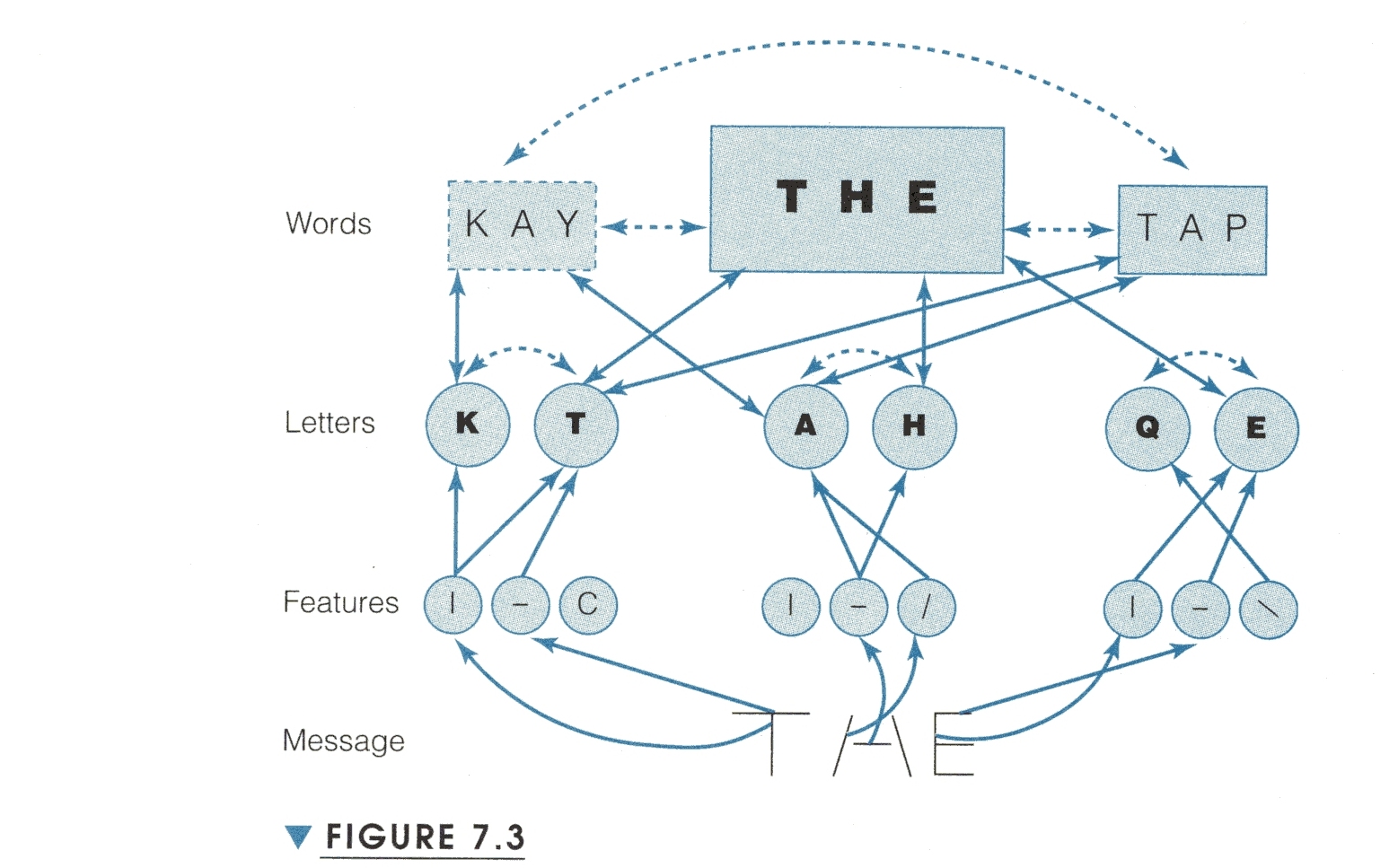| |
| Chapter 7 |
|
| Afterimage
|
that which arises after looking at a
visual stimulus, usually for several seconds. See
Positive afterimage; Negative afterimage
|
| Awareness
|
an issue in perception as to whether
an individual can respond perceptually to an event in
the absence of conscious awareness |
| Blindsight
|
according to Weiskrantz, the effect
of certain kinds of brain damage in which the subject
has an inability to recognize objects but retains the
ability to detect the presence and movement of objects
|
| Bottom-up
processing |
cognitive processes involving feature
extraction that begin with sensory stimulation |
| Conceptually
driven processing |
see Top-down processing |
| Converging
operations |
a set of related lines of
investigation that all bolster a common conclusion |
| Data-driven
processing |
see Bottom-up processing |
| Direct
approach to perception |
Gibson's idea that we directly pick
up and use the information afforded by the environment
|
| Double
dissociation of function |
a technique in which opposite
behaviors are elicited by two different tasks from
different areas of functioning (see Converging
operations) |
| Dynamic
perimetry |
a procedure, used to measure the
visual field, in which a small visual target is
gradually brought into the field of vision |
| Emmert's law
|
the size of an afterimage is
proportional to the viewing distance |
| Empirical
theory of perception |
the argument that perceptions are
determined entirely by past experience |
|
Hallucination |
a report of an experience in the
absence of any apparent stimulation |
| Illusion
|
a mistake or distorted perception
|
| Indirect
approach to perception |
the idea that perception results from
the interpretation of sensations |
| Masking
|
the technique of presenting a jumbled
visual stimulus immediately after a target stimulus in
order to stop the visual persistence of the target |
| Monitoring
task |
a form of dichotic listening in which
observers are not required to verbalize a message as it
is presented |
| Mozart
effect |
the finding that listening to Mozart
compositions leads to increased performance on
visual-spatial tests |
| Nativistic
theory of perception |
the theory that genetic "wired-in"
mechanisms account for perceptual capabilities (see
Empirical theory of perception) |
| Negative
afterimage |
is opposite in brightness and
complementary in color to the visual stimulus (contrast
with Positive afterimage) |
| Objective
threshold |
according to Cheesman and Merikle,
the stimulus energy level that elicits truly random
behavior (compare with Subjective threshold)
|
| Operationism
|
the position that concepts are
defined by the operations used to measure and produce
them, but ignores the fact that at least two sets of
observations are needed for a complete definition |
| Perception
|
the awareness process typically
viewed as more complex than sensation and usually
involving an interpretation of sensation |
| Perceptual
defense |
an unwillingness to report perceiving
unpleasant material, in contrast to an inability to
perceive such material |
|
Phenomenological experience |
a person's awareness of his or her
own state of mind |
| Positive
afterimage |
is similar in brightness and color to
the original visual stimulus |
| Prime sight
|
the after images perceived by patient
D.B. to visual stimuli for which he claimed to be blind
|
| Priming
|
facilitation of a response because of
a previous experience; e.g., prior presentation of a
word speeds later reading of the same word
|
| Scotoma
|
a region of blindness in the visual
field caused by a physical defect in the visual system
|
| Sensation
|
the basic and elemental intake of
stimulus information
|
| Stroop
effect |
difficulty in naming the color of an
object when the color conflicts with the name of the
object (when the word blue is printed in red ink)
|
| Subjective
threshold |
the stimulus energy level that yields
claims of unawareness but behavior indicating perception
of the event (see Objective threshold)
|
|
Tachistoscope |
a device that allows very rapid
presentation of visual stimuli
|
| Top-down
processing |
cognitive processes that begin with
knowledge of concepts; contrast with Bottom-up
processing |
| Unconscious
inference |
Helmholtz's view that perception
involves inferences about sensations and that the
observer is unaware of making the inferences |
| Verbal
report |
a subject's description of his or her
phenomenological experience, often very difficult to
verify |
